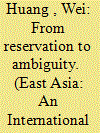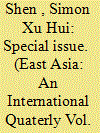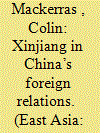|
|
|
Sort Order |
|
|
|
Items / Page
|
|
|
|
|
|
|
| Srl | Item |
| 1 |
ID:
138966


|
|
|
|
|
| Summary/Abstract |
This writing analyzes the use of symbols, art, and aesthetics in the first phase of Hong Kong’s “Occupy Central” movement. Protestors, demonstrators, and strikers appropriate symbols to put their political messages across, sometimes essentializing or reducing complicated and complex ideologies or reform initiatives to pictorial symbols and performative sessions to parsimoniously put their points across. Between the start of Hong Kong’s “Occupy Central” movement on 27 September 2014 and its temporary pause on 6 October 2014, many symbols and art forms were used to symbolize the protests including the yellow umbrella. This writing is based on the observations in Hong Kong (more than 4 years) as well as formal and informal discussions with individuals representing positions from all sides of the political divides (pro-government, pro-democracy, and pro-Beijing forces) within and outside Hong Kong. Textually, I collected media reports, downloaded digital images, and scanned and analyzed media commentaries for this writing.
|
|
|
|
|
|
|
|
|
|
|
|
|
|
|
|
| 2 |
ID:
138962


|
|
|
|
|
| Summary/Abstract |
The relationship between Turkey and the People’s Republic of China (PRC) has experienced some ups and downs from 1949 to present. In the first period of relations, Turkey was one of the countries that preferred to recognize the Republic of China (ROC) in Taiwan over the PRC, this lasted until 1970. The second period began when diplomatic relations were established between Turkey and the PRC in 1971. International security concerns and economic considerations have been among the major factors that shaped Sino–Turkish relations during these times in the 1970s and 1980s. In the third period, Ankara–Beijing relations seriously stagnated as a result of the Xinjiang issue and Ankara’s reestablishment of relations with Taipei during the 1990s. Turkey–PRC relations have come to exhibit a higher degree of multidimensionality in the fourth period starting in 2000. In addition to the increasing bilateral trade volume, the deepening economic and political cooperation between the two countries has also made Turkish–Chinese relations more important from a global standpoint. On the other hand, there are also a number of problems such as the mounting bilateral trade imbalance against Turkey, China’s deficiencies in the development of political, economic, and cultural rights of the Uyghurs, and uncertainties in determining the status of Ankara–Taipei relations. The steps that Ankara and Beijing will take with regard to the existing opportunities and possible challenges in bilateral relations will be decisive for future ties between the two countries. This article will analyze the key dynamics of Sino–Turkish relations, and in doing so, it will seek to determine how the relationship between the two countries has been shaped over time.
|
|
|
|
|
|
|
|
|
|
|
|
|
|
|
|
| 3 |
ID:
138965


|
|
|
|
|
| Summary/Abstract |
I examine the views of Chinese scholars during the decade of Hu’s leadership concerning China’s diplomatic strategy with respect to the judgment of China’s national power, the orientation of China’s diplomatic goals, and the choice of China’s foreign policy. Chinese scholars increasingly judged China as an emerging major power in a multi-polarizing world. The mainstream academic attitude was that China should augment its international role. The discourse on China’s diplomatic goals experienced a skillful and tacit transition from the “keep a low profile” principle to the “harmonious world” proposal, featured by the shift in emphasis, the expansion of interpretation, and the substitution of concepts. The Chinese academia unanimously endorsed the governmental proposal of the road of peaceful development, while ambiguity can be observed in China’s more assertive responses to challenges to its “core interests”, agenda setting attempts in multilateral cooperation, and various endeavors to gain “soft power”. Underlying the transition of China’s diplomatic strategy was the materialist way of thinking concerning international relations.
|
|
|
|
|
|
|
|
|
|
|
|
|
|
|
|
| 4 |
ID:
138961


|
|
|
|
|
| Summary/Abstract |
Coinciding with the rise of Chinese economy, China’s foreign policy has become more assertive than ever. As part of the “Chinese Dream” promise, her new projects, the “New Maritime Silk Road” and the “New Silk Road,” have created a new chapter of China’s relations with her neighboring countries as well as the international communities. However, China’s hidden agenda of the two new projects, her challenges of achieving her goals, and how the international communities respond to the increasingly assertive Chinese foreign policy are yet to be discussed extensively among research on international relations. This introduction seeks to outline a wide spectrum of theoretical framework that is applicable to the subject and to highlight the importance of understanding the context of China’s strategic shifts in Xi Jinping’s era.
|
|
|
|
|
|
|
|
|
|
|
|
|
|
|
|
| 5 |
ID:
138964


|
|
|
|
|
| Summary/Abstract |
This paper examines the 228 Uprising, which occurred in February 1947 in post-war Taiwan, employing Michael Mann’s IMEP model as the primary analytical framework and suggesting that the uprising was in nature an ethnic conflict heavily influenced by at least four types of structural factors: political, military, economic and ideological. This paper attempts to answer the following questions: What were the structural factors that contributed to the 228 Uprising? How should we interpret these factors to understand the nature of the uprising? Why did the Taiwanese people who participated in the riots act so violently against the provincial government in Taiwan? Factionalism and a low level of the state power were serious political problems, which resulted in lax military discipline and a failed statist economic policy. These military and economic conditions fuelled ideological discourses that called for democracy and self-governance by the Taiwanese. Moreover, the negative interactions between the Taiwanese and the Mainlanders contributed to the emergence of a Taiwanese ethnic identity and echoed those discourses. It can be argued that Taiwanese elites and masses fused their ethnic identity with their ideal of democracy. Thus, in the eyes of many Taiwanese participating in the uprising, that fusion justified violent actions against Chen Yi’s provincial regime and the military establishment in Taiwan.
|
|
|
|
|
|
|
|
|
|
|
|
|
|
|
|
| 6 |
ID:
138963


|
|
|
|
|
| Summary/Abstract |
This paper analyses how the situation in China’s most northwestern province-level unit Xinjiang has affected China’s overall foreign relations since disturbances in its capital Ürümqi in July 2009. Xinjiang’s most populous ethnic group is the mostly-Muslim Uighurs. The paper assumes a framework that puts a high priority on China’s facing west. Though no more important than the eastward-looking foreign policy that has dominated Western analysis, the paper sees China’s facing west perspective as deserving more attention than it has received. Russia and Central Asian countries have been positive about China’s economic aims in the region. However, friction has increased with China’s rise, Chinese authorities tending to blame Xinjiang’s disturbances on Islamism in Central Asia. China resents the USA for giving asylum to Rebiya Kadeer, president of the anti-China World Uyghur Congress. In 2011, US Secretary of State Hillary Clinton pushed the idea of a “New Silk Road” in Central Asia for peaceful economic development. China has long espoused the “Silk Road” idea, developing its own “Silk Road Economic Belt.” Damaged due to the 2009 riots, the China-Turkey relationship has improved because of various visits and agreements since 2010. The paper balances the dominantly economic Silk Road concept against Islamist terrorism. It argues that the aims of the Silk Road and Silk Road Economic Belt are sensible and practical, with positive economic relations the main trend. However, although the Central Asian “zone of conflict” is a lesser trend, tensions are serious and long term, especially those caused by Islamism and Islamist terrorism.
|
|
|
|
|
|
|
|
|
|
|
|
|
|
|
|
|
|
|
|
|